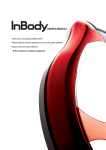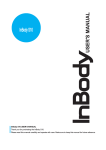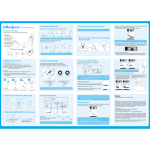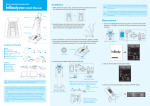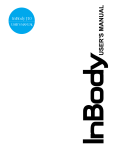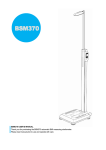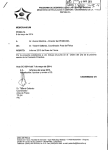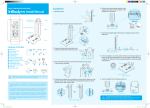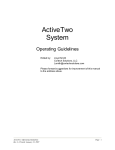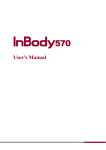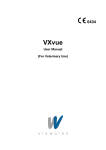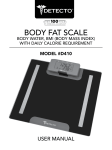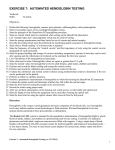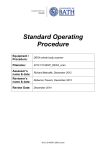Download InBody230 USER`S MANUAL
Transcript
InBody230 USER’S MANUAL Thank you for purchasing the InBody230. Please read this manual carefully and operate with care. Keep for future reference. ⓒ 1996- Biospace Co., Ltd. All rights reserved. Notice No part of this manual should be reproduced, stored in any retrieval system, or transmitted by any means (electronic, mechanical, photocopied, recorded, etc.) without written consent from Biospace, Inc.(hereinafter Biospace). No patient liability is assumed with respect to the use of the information contained herein. This User’s Manual may contain misprints, which can be modified without prior notice to the readers. Biospace is not liable for any damage caused by a failure to meet the requirements stated in User’s Manual. Biospace, Inc. 4801 Wilshire Blvd., Suite 320 Los Angeles, CA 90010, USA TEL : 1-323-932-6503 FAX : 1-323-932-6506 Homepage: http://www.biospaceamerica.com E-mail: usa@biospaceamerica.com Biospace Co., Ltd. [Head office] 518-10 Dogok 2- dong, Gangnam-gu, Seoul 135-854 KOREA TEL : 82-2-501-3939 FAX : 82-2-501-3978 Homepage : http://www.InBody.com E-mail : info@inbody.com Acknowledgements Biospace, the Biospace logo, and the InBody230 are registered trademarks of Biospace Co., Ltd. The names of the companies and products in this manual other than those of Biospace Co., Ltd. are the trademarks of those companies. Stating the products of other companies is strictly for the purpose of providing information, not to guarantee or recommend these products. Biospace is not responsible for the performance or the use of these products. Biospace reserves the right to modify the dimensions or exterior of the InBody230 to improve the quality of the product(s), without consent of the customer. BM-USA-40-J-121204 Introducing the InBody230 - BODY COMPOSITION ANALYZER Body Composition consists of 4 major components: Water, Protein, Minerals and Fat. These four elements are the fundamental ingredients the body is comprised of, and it is important for them to be in balance. Body composition analysis is expected to quantify and measure these ingredients. Until recently, diagnosing obesity has focused on appearance, without considering a balanced body composition. For more reasonable healthcare, accurate body composition analysis must be performed first, to achieve the balance of the four major body components. Biospace has earned international recognition for technical expertise demonstrated through the InBody series. Based on the experience and technology over the last 10 years, Biospace has released the body composition analyzer, the InBody230. With direct segmental measurement, the InBody230 guarantees high accuracy and reproducibility. The InBody230 yields accurate results unique to the individual, regardless of empirical estimations and reliably evaluates the effectiveness of diet control and exercise prescription. In addition, sophisticated design and measurement instructions with a flash screen allow for convenient use. Biospace is committed to providing advanced equipment to promote good health and a long life. Kichul Cha, CEO Contents How to use this manual Ⅰ Safety Information Ⅱ Indicators & Safety Symbols Ⅶ Workplace Requirements Ⅹ Chapter 1 Installation & Maintenance Chapter 3 Setup Establishment 1. Contents of the Box 1 1. Setup 46 2. Exterior & Functions 2 2. Setup Menu 47 3. Installation Instructions 9 3. Quick Setup 51 4. Transportation 14 4. Data Transfer 52 5. Repacking 15 6. Maintenance 17 Chapter 4 Problems & Solutions 1. Error Messages 53 Chapter 2 Management & Results Description 2. Troubleshooting 54 1. Cautions Before Measurement 18 3. Frequently Asked Question (FAQs) 57 2. Exterior and Function of Keypad 19 3. Power Connection & Getting Started 21 Chapter 5 Consumables 4. Standby Screen 22 1. Consumables 59 5. Personal Profile 23 2. Options 60 6. Proper Posture 24 7. How to Operate the Equipment 26 Appendix 8. Results 29 1. More about the InBody230 61 9. Facts for Normal Range 40 2. Specifications 64 3. Customer Service Information 65 How to use this manual The User’s Manual explains the functions of the InBody230. Follow the instructions below for effective use of this manual. 1. Please read all the instructions in this manual thoroughly before operation. 2. Fully utilize the helpful materials, such as the diagrams and illustrations, to get a clear understanding of the product. 3. Before calling Biospace for assistance, please refer to Chapter 4: “Problems & Solutions.” 4. To purchase consumable products or optional equipment, please refer to Chapter 5: “Consumables.” 5. If you have clinical issues while using the InBody230, please contact us using the e-mail address as shown below. E-mail: USA@biospaceamerica.com 6. Most importantly, please read the instructions and become familiar with the following notations: Important information to warn you of situations which might cause major injury and/or damage to property if instructions are not carefully followed. Important information to warn you of situations which might cause minor injury and/or damage to property if instructions are not carefully followed. Important helpful information for operating the InBody230. I Safety Information Make sure not to use this equipment with those that have medical electrical devices, such as a pacemaker. NO USAR USARLO CON EQUIPO MEDICO ELECTRONICO ASI COMO CON MARCAPASOS. Keep this equipment away from liquid. MANTENER USARLO LEJOS DEL AGUA. Do not aggressively grab the hand electrode/bar. NO AGARRAR LOS ELECTRODOS DE MANO FUERTEMENTE. WARNING Please do not dismantle the equipment. Dismantling may cause damage, such as electric shock. If dismantled, the Warranty will be void. II Do not use this equipment in combination with the following electronic medical devices. - Medical devices, such as a pacemaker - Electronic life support systems, such as an artificial heart/lung - Portable electronic medical devices, such as an electrocardiograph Do not operate within 3.5 feet from shockwave or microwave therapy equipment. Avoid simultaneously connecting patients to the InBody230 and any type of high frequency surgical equipment. 1. This product should always be placed on the ground and plugged into a secure electrical outlet. 2. Do not operate within 3.5 feet (1 meter) of any other powered electronic medical equipment. This will result in electromagnetic interference or possibly other interferences between the InBody230 and other equipment. 3. To prevent electric shock, use a surge protector in between the InBody230 and power outlet. 4. Do not dismantle the equipment or open the back cover. Internal parts are not for customer use. If the equipment is dismantled, the warranty is void, and service costs will be charged. If service is required, contact Biospace or the supplying agency. Only to service personal for battery replacement: Lithium Battery Type: CR2032. CAUTION-Danger of explosion if battery is incorrectly replaced. 5. When connecting peripherals (printers and other optional devices) to the InBody230, turn on the power of the peripherals before turning on the InBody230. When turning the power off, turn off the InBody230 before turning off the peripherals. This process will minimize the harm to the equipment caused by electrical shock. 6. The arm consists of a hand electrode, a joint and a bar. Do not force the arm in the wrong direction. The resulting damage may affect the functioning of the internal cable and circuit board. III 7. Do not operate this equipment with a damaged power cord or plug, if it is not working properly, or if it has been previously damaged in any way. 8. Do not submerge the power cord in water. 9. Individuals with any kind of contagious disease or any kind of injury on the palm of their hand or sole of their foot should not come in contact with this product. 10. Never start weight reduction or exercise therapy without instruction from a physician or a specialist. Self-diagnosis may damage your health. Consult with your physician first. 11. This equipment is specifically designed to analyze body composition. Use the equipment only for its intended use as described in this manual. 1. While moving, installing or using this product, be sure to protect it against any physical shock or damage. Always use the packing material and the original shipping box when moving or transporting this product. 2. Always operate this product within prescribed ranges of temperature, humidity, and pressure. Operating in ranges outside of those specified may affect the operation of this product and may cause malfunctions. 3. Follow local governing ordinances and recycling plans regarding the disposal or recycling of device components. 4. Be careful not to spill or drop any residues of food or beverages on this product. It may cause serious damage to the electronic components. 5. Install or locate equipment only in accordance with the provided installation instructions. 6. This equipment should be serviced only by qualified personnel. Contact Biospace for any Customer Service issues. 7. Do not touch the ports on the backside of the InBody. IV This equipment may cause the above mentioned medical devices to malfunction. This equipment may cause harmful interference to other devices in the vicinity, if not installed and used in accordance with the installation specifications. However, there is no guarantee that the interference will not occur for a particular installation. The InBody230 has been designed, manufactured, and inspected under the full quality assurance system of Biospace. Biospace fulfills the international standardization system, ISO 90001 and ISO 13485 and the InBody230 has achieved FDA approval (Food and Drug Administration). The InBody230 fulfills the Standards of IEC60601-1(EN60601-1), Safety of Electric Medical Equipment. In addition, the InBody230 complies not only with Level A for Noise Immunity, but also with Level A for Noise Emission by the Standard IEC60601-1-2(EN60601-1-2), Electromagnetic Compatibility Requirements. 1. Potential electromagnetic or other interference between medical equipments and other devices being operated together in the same environment may emit an adverse influence on functioning of the medical equipment. Non-medical equipments not in compliance with the requirements of EN 60601-1 and EN 60601-1-2 should not be used together in the same environment as the medical equipments. This equipment has been tested and found to comply with the limits for medical devices in IEC 60601-1-2:2001. These limits are designed to provide reasonable protection against harmful interference in a controlled medical installation. 2. External equipment intended for connection to signal input, signal output, or other connectors, must comply with the relevant IEC/EN standard (IEC/EN 60601-1 series for medical electrical equipment). In addition, all such connections (system) must comply with the standard IEC/EN 60601-1 safety requirements for medical electrical systems. Any person who connects external equipment to signal input, signal output, or other connectors has formed a system and is therefore responsible for the system to comply with the requirements of IEC/EN 60601-1-1. If in doubt, speak with a qualified technician. V 3. Do not to touch the signal input, signal output or other connectors, and the patient simultaneously. However, there is no guarantee that the interference will not occur for a particular installation. The InBody230 has been designed, manufactured, and inspected under the full quality assurance system of Biospace. Biospace fulfills the international standardization system, ISO 90001 and ISO 13485 and achieved FDA approval (Food and Drug Administration). The InBody230 fulfills the Standards of IEC60601-1(EN60601-1), Safety of Electric Medical Equipment. In addition, the InBody230 complies not only with Level A for Noise Immunity, but also with Level A for Noise Emission by the Standard IEC60601-1-2(EN60601-1-2), Electromagnetic Compatibility Requirements. VI Indicators & Safety Symbols A. Indicators B. Safety Symbols Use the adapter provided/recommended by Biospace. (Adapter; JEC Korea Corp., MW160) For 120V input power, use only UL Listed detachable power cord with NEMA configuration 5-15P type, hospital grade plug(parallel blades). For 240V input power, use only UL Listed detachable power cord with NEMA configuration 6-15P type hospital grade plug(Tandem blades). VII C. Care Marks on the Box D. Keypad Buttons VIII E. Others Disposal of old Electrical/Electronic Equipment (Application in the European Union and other European countries with separate collection system) This symbol indicates that this product shall not be treated as household waste. Instead, it shall be handed over to the applicable collection point for the recycling of electrical and electronic equipment. By ensuring this product is disposed of correctly, you will help prevent potential negative consequences for the environment and human health, which could otherwise be caused by inappropriate waste handling of this product. For more detailed information about recycling this product, please refer to local governing ordinances and recycling plans. IX Workplace Requirements □ Operation Environment Temperature range 50℉ ~ 104℉ (10 ~ 40 ℃) Relative humidity 30 ~ 80 % Atmospheric pressure range 50 ~ 106 kPa □ Transport and Storage Environment Temperature range 32℉ ~ 104℉(0 ~ 40℃) Relative humidity 30 ~ 80 % (No condensation) Atmospheric pressure range 50 ~ 106 kPa □ Adapter Power Input AC 100 - 240V, 50/60Hz, 1.2A Power Output DC 12V, 3.5A X Chapter1 Installation & Maintenance 1. Contents of the Box 2. Exterior & Functions 3. Installation Instructions 4. Transportation 5. Repacking 6. Maintenance 1. Contents of the Box When opening the box, make sure all of the following items are inside. 1.USB Cable is to be purchased separately for connecting to the printer. 2.The printer is needed for printing the result sheets. Please check the compatibility of the printer with Biospace. To prevent physical shock, use Biospace’s packing material when shipping or transporting the equipment. Refer to this Chapter, Section 4: “Transportation.” 1 2. Exterior & Functions Individual part identification and functions with schematic sketches are provided below. Please inspect each component of the InBody230 before installation to ensure there are no scratches or damage. A. Operation Part B. Upper Part C. Lower Part D. Rear Part 2 A. Operation Part (1) LCD Monitor (320 × 240 color STN LCD) This displays the analysis procedure, messages and results. (2) Key Pad (23 buttons) The keypad is divisible into input buttons and function buttons. These are used to input data required for body composition analysis, to set up the operating environment and to print out test results. B. Upper Part (1) Thumb Electrode Activated by making contact with the thumb, thus allowing current to flow through the body during measurement. (2) Palm Electrode Activated by wrapping the palm around the electrode, thus allowing current to flow through the body during measurement. (3) Hand Electrode Joint and Hand Electrode bar Supports Hand Electrode and contains electrical cables. 3 (4) Body Stand C. Lower Part (1) Front Sole Electrode Activated by placing the fore-foot directly on the front sole electrode. This allows the current to flow through the body. (2) Rear Sole Electrode Activated by placing the heel of the foot directly on the rear sole electrode. (3) Base Frame The loadcell, which measures body weight, is underneath the Base Frame. (4) Joint Frame Connects upper part and lower part. (5) Joint Screw Used to tighten the body stand after raising it. 4 (6) Level Indicator Used to level the InBody230 by means of a view glass and bubble alignment. (7) Level Screws There are 4 leveling screws that support the equipment. Leveling screws are designed to be turned by hand, so you can easily adjust the balance of the equipment. 5 D. Rear Part (1) Back Cover Only qualified personnel are allowed to remove the back cover. Do not dismantle the equipment or open the back cover. Internal parts are not for customer use and may cause electric shock. If the equipment is dismantled, the warranty is void, and service costs will be charged. 6 (2) Control & Connection Unit Connects to peripherals such as a PC or a printer for data transmission. ①Power Switch Power the InBody230 on/off. ②LCD Contrast Control Used to adjust LCD brightness. Turn right to darken and turn left to brighten. <Darker> <Brighter> ③ Power Input Port Used to connect the power adapter. 7 ④ 9pin Serial Port, Female (RS232C) Used to connect optional devices provided by Biospace. ⑤USB Host Port Used to interface with a USB printer or a USB Storage Device. You can use either of the two USB ports interchangeably. ⑥ USB Slave Port Used to connect with a PC. Do not touch signal input, signal output or other connectors, and the patient simultaneously. External equipment intended for connection to signal input, signal output or other connectors, shall comply with relevant IEC Standard(e.g., IEC60950 for IT equipment and IEC60601-1 series for medical electrical equipment). In addition, all such combination- system-shall comply with the standard IEC60601-1 and/or IEC60601-1-1 harmonized national standard or the combination. If, in doubt, contact qualified technician or your local representative. Important information to warn you of situations which might cause major injury and/or damage to property if instructions are not carefully followed. Use only the power cord provided by Biospace to connect to the power port. When you use the adapter cable, insert the adapter cable tightly into the InBody230. Including the optional equipment, only the peripherals provided by Biospace can be connected to the InBody230. For any inquiry about peripherals, contact Biospace. (3) Speaker A signal sound informs users of status, such as process or completion of the measurement. 8 3. Installation Instructions A. Workplace requirements (1) Location: Indoor only. Any outdoor area where the equipment is to be located should meet all the conditions below. (2) Operation environment: 50 ~ 104 °F (10 ~ 40 °C), 30 ~ 80% RH (3) Optimum pressure: 50 ~ 106kPa (4) Adapter: Power Input 100-240V, 50-60Hz, 1.2A Power Output DC 12V, 3.5A B. Note on Unpacking & Assembling Be sure to read these instructions carefully before assembling. (1) Place the equipment on level ground. (2) Do not move by holding the hand electrode joints or control part with LCD. < Correct > < Incorrect > 9 C. Unpacking & Assembling (1) Open the box and remove the top pad. Place the InBody230 horizontal to the ground. (2) Raise the body stand of the equipment carefully until it stands upright. (3 Raise the head part upward and lower the arms. 10 (4 Push the knob in, as shown below and turn it clockwise to tighten the joint screw. (5) Plug the power adapter cable into the InBody230 and plug the printer cable into the printer USB host, like in the picture below. Adapter Printer Cable *Make sure the power cord is firmly plugged in. 11 (6) If the air bubble is not in the center of the level indicator, tighten or loosen the leveling screws(4EA) on the foot plate to adjust the level. The InBody230 must be leveled properly for accurate weight measurement. 12 (7) Turn on the InBody230 and the calibration/warm up process will begin. This will take approximately 15 seconds. During the warming, do not touch the base. Do not touch the base frame when turning on the machine and while it is warming up. During self-calibration, the loadcell inside the base frame is calibrated under a zero weight condition. Applying pressure or weight to the base frame during self-calibration will result in an inaccurate calibration. When connecting peripherals (printers and other optional devices) to the InBody230, turn on the power of peripherals before turning on the InBody230. When turning the power off, turn off the InBody230 before turning off the peripherals. 13 4. Transportation If it must be transported, be extra careful to ensure safe handling. The following are some tips for safely transporting the InBody230: (1) Before transporting the InBody230, turn off the power switch and unplug the adapter. (2) Be careful not to damage the hand module. (3) After moving the InBody230, ensure that it is placed horizontal to the ground. A. Environmental Requirements Transport and Storage Environment : 32℉ ~ 104℉(0 ~ 40℃), 30 ~ 80%RH (No condensation) 50 ~ 106kPa B. Transporting Before Installation Before installation, the InBody230 is shipped in the box designed by Biospace. For safety, have two people move it by holding both sides or use handling equipment such as a cart or dolly. Be careful with fragile freight. The package has fragile operation parts including LCD, which has the sign on the box. After relocating the InBody230, make sure it is level again. Inaccurate leveling will affect accuracy of individual weight measurements. 14 5. Repacking Be sure to turn off the power switch and unplug the power cable before repacking. Be careful to avoid severe physical shock, jarring or other damage while repacking, especially with regard to the arm and foot electrodes. (1) Turn off the power switch. Remove all cables connected to the InBody230. (If a thermal printer is attached to the unit, remove the thermal printer first) (2) Raise the hand electrodes and make them parallel with the equipment’s head. (3) Step onto the foot board and slowly fold the head part with hand electrodes until it reaches to the back of the equipment. 15 (4) Loosen the joint screw to the left counterclockwise and fold the head and lower the stand towards the foot board. For the InBody box users (5) Put the equipment in the box. (6) Seal the box with a tape. For the InBody bag users (7) Place the equipment in the bag as illustrated below. 16 6. Maintenance (1) After usage, wipe electrodes with a wet tissue (also known as wet naps, surface wipes, anti-bacterial tissues, etc.) Wet tissues can be purchased at any local store. (2) Handle the arms with care. Never apply excessive force near the hand electrode joint. The damage caused by misuse may affect the function of the internal cable and electric board. (3) Do not place anything on the base frame or apply any pressure onto it when the InBody230 is not in use. (4) When the InBody230 is not in use for a period longer than one day, unplug the adapter. (5) Do not move or relocate the InBody230 while the power is on. (6) Do not drop any food or liquid on the equipment. It may affect the electrical parts in the equipment or cause damage. (7) Once a week, wipe the exterior sides of the InBody230 with a dry towel. In particular, clean the LCD monitor, using gentle care not to scratch the surface. (8) Follow local governing ordinances and recycling plans regarding the disposal or recycling of device components. 17 Chapter 2. Management & Results Description 1. Cautions Before Measurement 2. Exterior and Functions of Keypad 3. Power Connection & Getting Started 4. Standby Screen 5. Personal Profile 6. Proper Posture 7. How to Operate the Equipment 8. Results 9. Facts for Normal Range 18 1. Cautions Before Measurement To observe changes of the human body through body composition analysis, it is crucial to perform the analysis each time under the same conditions, temperature, posture, etc. Bear in mind, the following factors affect the results of body composition analysis, and as a result, affect the reproducibility of analysis. (1) Do not exercise or perform any physical activities before testing. If a examinee has already been physically active, a temporary change in body composition will result. (2) Do not eat before measurement. If an examinee already ate, wait 2 hours for digestion. (3) Do not take a bath or shower prior to measurement. Perspiring (sweating) that occurs also results in a temporary change in body composition. (4) Perform the measurement under normal temperature conditions 68~77 °F (20~25 °C). If the ambient temperature is too high or too low, the human body responds, resulting in temporary changes in body composition. (5) Perform the measurement after urination or excretion, if possible. Residues inside the human body are interpreted as fat mass. Waste in the body means the analysis will be less accurate. (6) Measurement should ideally be done before mid-day. In the afternoon, after being mobile all day, more body water will accumulate in the lower body, yielding an unequal distribution. 18 2. Exterior and Functions of Keypad The InBody230 has a keypad for data input. To input all information, press the relevant buttons on the keypad. Keypad is located below the display screen. It can be distinguished into 2 categories by their functions. A. Input Button (1) Numerical Buttons (0~9) / Alphabet Buttons (A~Z) The input buttons are used to enter alpha-numeric data such as the patient’s age, height and I.D. With each button, the alpha-numerics are displayed in the sequence shown on the keypad. For instance, when you press the button 2, you will see a set of alpha-numeric representations assigned to the button showing up in the pre-determined order of 2, A, B and C. (2) Period / Comma Button This button is used to enter a decimal point or comma for height, age, I.D., and weight. (3) Backspace Button Used to delete entered data. (4) ENTER Button This button is used when data input is finished or to move on to the next item, or to store modified values in the Setup Menu. (5) Gender Selection Button It is used for gender input when entering personal profile ( : Female, : Male). 19 B. Function Button (6) Direction Buttons The directional buttons consist of up, down, left and right. (7) SETUP Button Used to update or modify the user environment. (8) MODE Button MODE button is used to set “Quick Setup” for the unit, results sheet, etc. at the initial screen. Refer to “Chapter 3, Setup Establishment” for the instructions for quick setup. (9) EXIT Button EXIT button is used to stop the process that is in progress or go back to the previous process. (10) PRINT Button You can print out an extra result sheet of the last tested examinee when you press the PRINT button at standby screen. Unless another examinee steps on the base frame and completes the measurement, the last data will not be deleted and you can print it later. 20 3. Power Connection & Getting Started (1) Connect the adapter cable to the power input port. (2) When system switch is turned on, the screen is displayed as illustrated below and starts warming up by itself. The warming up lasts for about 15 seconds. (3) During the warm up, the InBody230 processes the self-testing, zero point calibration for the scale, and adjustment of the internal circuit. Also, it checks the usage status of the peripherals registered in the Setup menu and displays it on the state window of the screen. (4) As the warm up ends and the current setting status appears, it becomes ready for the measurement with a signal sound. When connecting peripherals (printers and other optional devices) to the InBody230, turn on the power of peripherals before turning on the InBody230.When turning the power off, turn off the InBody230 first before turning off the peripherals. This process will minimize harm to the equipment caused by electric shock. Do not touch the base frame when turning on and during warm up. Applying pressure or weight to the base frame during warm up will result in an inaccurate calibration, which may cause the measurements to be inaccurate. 21 4. Standby Screen The standby screen of the InBody230 consists of various items for both examinee and user’s convenience. It can be distinguished into 4 categories as shown below. (1) Personal Information Window This is for I.D., age, height, gender and weight. (2) Information Window This area displays the process and completion of the measurement providing helpful and specific information for the examinees and the users. (3) Analysis Results Window Before printing out the results, you can check the key figures on the window. All figures shown in the window are printed on the result sheet. (4) Lower Menu Bar The lower menu bar shows setting options registered in the InBody230 such as the current time, peripherals, units, result sheet, and sound setup. 22 5. Personal Profile Height and weight are essential information for body composition analysis, and for more comprehension, age and gender are used to provide standard range. The InBody230 analyzes the measurement results based on the input data. To reduce errors and acquire more reliable results, input examinee data after reading the following carefully. (1) I.D. (permitted range: 20 Characters) Use the keypad to enter I.D. Press the button that corresponds to the letter in the sequence shown on the keypad. (2) Age (permitted range: 3 years ~ 99 years) Use the keypad to enter age. For optimal accuracy, for examinees under the age of 18, you may include a decimal point when inputting their age. Example: 13 and 6 months years old = 13 years + 6 months/12 months = 13.5 (3) Height (permitted range: 2ft. 9.5in. ~ 7ft. 2.6in / 85cm ~ 220cm) Use the keypad to enter height. It is possible to select the unit you want to use between inches and cm. If the chosen unit is ft./in., it is possible to input one decimal place. (4) Gender You can select the gender by using the or buttons. (5) Weight (permitted range: 22 lb. ~ 551 lb. / 10kg ~ 250kg) The measured weight is automatically added to the weight column. You can change the units by using the MODE button. When the unit is changed, the weight will change automatically. It is also possible to adjust the weight to account for clothing weight and accessories. 23 6. Proper Posture Proper posture is essential to achieve reliable results and high reproducibility. To minimize errors and improve reliability, keep the following in mind. A. How to hold the hand electrodes (1) Make parallel, flat contact with four fingers on the surface of the electrode. (2) Place thumb on the electrode pad on the top surface of the handle. Touch lightly, do not press with nails, and do not press down too hard. (3) When holding the hand electrodes, make sure your thumbs are covering the thumb electrodes and hold the palm electrodes with the rest of your hands. <Wrong posture> <Right posture> Do not press the electrodes with the fingernails; fingernails may damage the electrodes and cause inaccurate results. B. How to stand on the foot electrodes (1) Bare feet must be in contact with the electrodes. (2) Make sure to place the heel on the circular (rear sole) electrode. (3) Then, place the sole on the elliptical (front sole) electrode surface. <Right posture> <Wrong posture> 24 Do not allow pants to disrupt contact between the heels and the electrodes. If the foot is exceptionally small, place it between the electrodes, ensuring that it makes contact with both sets of electrodes. Measurements may not be possible due to dry/hardened skin on the palm or sole. In this case, wipe the palm and sole with a wet tissue before measuring. Be careful not to spill water on the electrodes. Excessive water may cause corrosion or other problems. C. Body Posture The proper body posture is a normal standing position with the arms and legs extended. For accurate results, please take off heavy clothes and accessories. (1) Avoid direct contact between the arms and the body at the armpit and between the legs at the crotch. It is recommended to stretch your arms about 15 degrees off the body during the analysis. (2) The examinee should remain relaxed and avoid straining or moving the body during the analysis. When the examinee cannot maintain proper posture during the analysis, an assistant may be required to ensure proper posture. The assistant or technician must take care not to inadvertently make skin contact with the examinee. The InBody230 cannot be performed if an examinee is missing a hand, a thumb or a foot. 25 7. How to Operate the Equipment The following procedure is based on the initial setting of the InBody230. If an examinee steps down from the InBody230 during measurement, the procedure is automatically cancelled. (1) Confirm the InBody230 is ready for measurement. If it is ready, the following screen is displayed. (2) Remove heavy clothes and accessories before weighing examinee. (3) Stand on the base frame of the InBody230. Be sure to match the examinee’s heels with the rear sole electrodes and examinee’s soles with the front sole electrodes. Bare feet must be in contact the electrodes. When an examinee steps onto the InBody230, individual’s weight is displayed at the information window of the screen. While the device is measuring weight, stand at attention and do not move until the measured value on the screen settles at the examinee’s correct weight. If the examinee wants to be re-measured, the examinee has to step down from the base frame of the machine and step up on the base frame again. 26 (4) After weight measurement, weight value is displayed at the personal information window respectively. Input I.D., age, height, and gender using buttons on keypad. Then entered values will be added on the personal information window. After, check the entered data, then press ENTER. (5) An examinee must assume the proper posture. The InBody230 checks the posture continuously. Once measurement is started, the examinee should maintain correct posture until completed. If the entered data is out of the acceptable data range, the Error Message will pop up on the LCD. Enter the examinee’s data again. Refer to Section 5: “Personal Profile” for the acceptable range of each data Measurement may not take place if the palms or soles are too dry or have hardened skin. tissue before measuring. In this case, wipe the palms or soles with a wet 27 (6) During measurements, the InBody230 displays the results of the examinee’s body composition analysis. The measurement takes approximately 35 seconds. (7) When the measurement is finished, the completion message appears in the information window with a signal sound. (8) Return each hand electrode back to its original position, and step down from the base frame. Do not turn the arm bar by force. If a bar is twisted, the InBody230 may malfunction because important cables are located inside of the hand electrode bars. (9) When a printer is connected, it automatically prints the result sheet. Then the InBody230 goes back to the standby screen. If you want an additional copy of the result sheet, press ‘PRINT’ button. Refer to “Section 8: Results.” 28 8. Results A. Result Screen During measurement, the InBody230 displays information of an examinee’s body composition on the LCD. The results are shown on the LCD while an examinee is standing on the machine. As soon as the examinee steps down, it goes back to the standby screen, and the InBody230 is ready for measurement again. Through the display of the results, you can check the main items of the results that the InBody230 will print out. B. Result Sheet With a printer connected to the InBody230, result sheets can be printed out. (1) Printer Connection ① USB Printers. Use the printers recommended by Biospace. Refer to “Chapter 5 Consumables” and the User’s Manual provided by the printer manufacturer for installation of a printer. ② Thermal Printer (optional) A thermal printer provided by Biospace can be used with InBody230. Refer to “Chapter 5: Consumables” for the instruction. 29 (2) Result Sheet Form ① USB Printer The result sheets are consumable. Use letter size paper or the printed result sheet provided by Biospace. Please contact Biospace or an authorized distributor to place a purchase order. 30 ② Thermal Printer The roll paper is consumable. Use the roll paper which Biospace provides. Please contact Biospace or an authorized distributor to place the purchase order. 31 C. Output Items The following are the explanations for each item. The normal range on the result sheet is the standard provided by Biospace based on the Biospace possessed reference data. Basically, the result sheet shows measured values for each test item. Regarding the standard result as 100%, it shows the ratio of measured values to standard values with the bar graph’s length. The normal range will be set according to the standard value to enhance examinee’s easy understanding of result sheet. (1) Personal Information The examinee’s name ID, gender, age, height, exam date and time are displayed here. (2) Body Composition The InBody230 assigns a quantitative value to the select elements of the body’s composition. These values demonstrate the weight of each compositional element which comprises the examinee’s total body weight. ① Total Body Water (lbs.) TBW means the total water in our body, which amounts around 50%~70% of the weight. TBW is the most essential component in our bodily fluid that is essential. Balanced TBW is a basic requirement for a healthy life. Mostly TBW is in cells of muscle mass. While a healthy person’s muscle is over 70% of water, dry lean mass or body fat has very little water. As most of the TBW is in the lean body mass, the difference of people’s TBW is significant. People with over body fat have TBW of about 50% of their weight, but athletes with developed muscle mass have TBW of up to 70% of their weight. 32 ② Dry Lean Mass (lbs.) Dry Lean Mass is the sum of protein and minerals. Protein is solid in body cells, comprised of polymers of organic compounds, including nitrogen, and is a major component of muscle. Protein is also the main component of Dry Lean Mass. Minerals, the other component of Dry Lean Mass, help preserve the body and play important role in the human body. The quantity of minerals is closely related to the level of exercise of an examinee. When the muscle mass increases, the weight of the bone also increases. The InBody230 uses the following formula to measure Dry Lean Mass: Dry Lean Mass = Lean Body Mass – Total Body Water Protein is directly related to intracellular water. A lack of protein indicates poor nutrition, but contrary to what one may think, this protein is not the same as the one found in food. Dry Lean Mass is proportionate to the quantity of muscle. Protein and intracellular water are indications of the level of muscle content an individual has. ③ Body Fat Mass (lbs.) Body Fat Mass indicates the total quantity of lipids that can be extracted from fat and other cells. Body Fat Mass is not directly measured using the BIA method, but is the remaining value after subtracting Lean Body Mass from the total body weight. The InBody230 uses the following formula to measure Body Fat Mass: Body Fat Mass = Body Weight – Lean Body Mass Body Fat Mass is stored under the skin, in visceral areas and between muscles. When an examinee’s fat mass is higher than the normal range, he/she may be diagnosed as being overweight or obese (excess body fat). The range of diseases that can result from obesity may include hypertension, arteriosclerosis, hyperlipemia, fatty liver, cholelithiasis, diabetes, obstetrical diseases, breast cancer, and endometritis. ④ Lean Body Mass (lbs.) Lean Body Mass refers to the entire body weight with exception of Body Fat Mass. Athletes have a higher proportion of Lean Body Mass than regular people. As such, it is important for athletes to measure their Lean Body Mass. The InBody230 provides both basic and comprehensive data which can be used to evaluate the health of an examinee. ⑤ Weight (lbs.) The InBody230’s technology separates body weight into Total Body Water, Dry Lean Mass, and Body Fat. Body weight is the total sum of these three components. Weight = Total Body Water + Dry Lean Mass + Body Fat Mass 33 (3) Body Composition Analysis The horizontal bar graph helps you understand your body composition state compared to standard values. The numbers next to the bar graphs indicate the numerical values for the specific field. The length on the bar graph indicates where the examinee falls in relationship to the normal range. Each compositional element has its own absolute value. The lengths of the bar graphs indicate the percentage of the standard value for each compositional element. Therefore, a score of 100% indicates the standard value calculated based on the standard weight for that particular individual. When an individual controls his/her exercise levels and diet as part of a weight management program, the body composition of Body Fat Mass and Skeletal Muscle Mass change. ① Weight (lbs.) Standard weight indicates the ideal value in accordance with the examinee’s height. The InBody230 provides the standard weight range, based on the BMI (Body Mass Index) Standard Weight Index. *BMI method 2 Standard Weight(kg) = ideal BMI * Height (㎡ ) The Obesity Index indicates the level of obesity. Generally, a BMI of 18.5 – 24.9 is used to determine the normal weight range. With the InBody230, the normal weight range is ±15% of standard value, very similar to one based on BMI (18.5 – 25). Standard weight is determined according to a BMI of 22 for males, a BMI of 21.5 for females. ② Skeletal Muscle Mass (lbs.) There are three types of muscle – cardiac muscle, visceral muscle and skeletal muscle – the skeletal muscle is attached to the skeleton. Skeletal muscle is known to increase more easily through exercise. By comparing the percentage of body fat mass and skeletal muscle mass found in each body component, the level of obesity can be estimated in a more pro-active manner. Distinctively, skeletal muscle mass, which generally indicates the lean body mass of each arm and leg, can be controlled by exercise and dietary habits. Compare the length of the bar graphs for skeletal muscle mass and body fat mass. If the bar of skeletal muscle mass is relatively shorter and under the standard value, lean body mass is lacking in the body, while the opposite case will show the sufficiency. 100% signifies ideal skeletal muscle mass when examinee’s weight is 34 normal. Ideally, the skeletal muscle mass bar should be longer. If not, a weight control program is recommended. The normal range is 90~110% of standard skeletal muscle mass based on standard weight. ③ Body Fat Mass (lbs.) The normal range of Body Fat Mass is ascertained by calculating an examinee’s body fat mass as compared to the standard weight and standard Body Fat Mass. The InBody230 displays the percentage of the standard value of Body Fat Mass in a bar graph. (4) Obesity Analysis By analyzing the examinee’s weight using BMI and Percentage of Body Fat, the InBody230 Analyzer makes it possible to screen for sarcopenic obesity. People included in this sarcopenic obesity type fall within the normal range when it comes to BMI and weight, but are regarded as obese when their percentage of body fat is calculated. Normal range Males Females BMI 22 (normal range: 18.5-24.9) 21.5 ( normal range: 18.5 – 24.9) Percentage of Body Fat 10-20% 18%-28% 35 ① BMI (Body Mass Index, kg/㎡) 2 As we can see from the formula, BMI = weight (kg) ÷ height (㎡), BMI is used to approximate obesity levels. The BMI method has been widely applied in general medicine, dietary, and sports medicine fields as the main means of detecting obesity. However, this method is flawed in that it cannot be applied to adults with high levels of LBM, children, or those over the age of 65. Nevertheless, as the BMI has been the most commonly used index, much research on using the BMI method to prevent adult diseases has been conducted. This is why the InBody230 also includes BMI based information. Differences have emerged among researchers as to which standards should be used to determine the BMI of examinees of different age and gender. The InBody230 uses the World Health Organization (WHO) standards as the standard ranges for BMI (1998). The InBody230 identifies the standard BMI as 22 for males, 21.5 for females and the normal ranges as 18.5 – 24.9 for both males and females. Determination 1) WHO Standard BMI(kg/㎡) Classification Diagnosis <18.5 Underweight Under Infectious disease, malnutrition related disease 18.5~24.9 Normal Standard Least risk at most disease 25.0~29.9 Overweight 30.0~34.9 Obese1 35.0~39.9 Obese2 ≥40 Severely Obese May cause health problem Over Increase of the risk of cardiac disease, high blood pressure, diabetes, etc Ref. WHO and the National Heart, Lung, and Blood Institute: clinical guidelines on the identification, evaluation, and treatment of overweight and obesity in adults, the evidence report. June 1998, xiv ② Percentage of Body Fat (%) Percentage of Body Fat indicates the percentage of Body Fat to Body Weight. Percentage of Body Fat (%) = Body Fat Mass / Body Weight ⅹ100 The standard Percentage of Body Fat is 15% for males and 23% for females. When a person’s Percentage of Body Fat is calculated as being beyond the normal range, he/she is regarded as being overweight/obese. When a person’s Percentage of Body Fat falls below the normal range, he/she is regarded as having a low level of body fat. This low level of body fat can be separated into two types: The first is a person whose muscle type is deemed to account for a desirable proportion of the body composition. Such people’s weight is regarded as being within the normal range or falling within the overweight range. The second type, the poor nutrition type, is one in which a person’s body is deemed to be in an unhealthy state because of a lack of Body Fat Mass and LBM. This type has a higher possibility of contracting clinical diseases. 36 Ref. Lee RD, Nieman DC, Nutritional Assessment, 2nd edition, pp.264 Ref. Bray GA, Contemporary Diagnosis and Management of Obesity, pp.13, 1998 cf. In case of children less than 18 years old, different standards are applied as it is necessary to consider the difference in physical characteristics form adults. Ref. Samuel J. Fomon, M.D., et al. Body Composition of reference children from birth to age 10 years. The American Journal of Clinical Nutrition, 35, 1169-1175, 1982. (5) Segmental Lean Analysis With the InBody230, you can measure the lean body mass of your body parts. It is achieved through the use of one of the InBody230’s measuring principles, bioelectrical impedance measurements of body parts. The measurement of lean body mass for body parts is based on the following theory: 2 Segmental Lean Body Mass ∝ (Height) /(Segmental Resistance) Ref. Samuel J. Fomon, M.D., et al. Body composition of reference children form birth to age 10 years. The American journal of Clinical Nutrition, 35, 1169~1175, 1982. Ref. Henry C. Lukaski, Phyllis E. Johnson, William W. Bolonchuk and Glenn I. Lykken, Assessment of fat – free mass using bioelectrical impedance measurements of the human body, The American J. of Clinical Nutrition, Vol.41, pp810-817, 1985 The InBody230’s segmental analysis method measures lean body mass using segmental analysis data on each body part; right arm, left arm, trunk, right leg, and left leg. The measured values are presented in a model of the human body for easy understanding. Measured values are listed under the appropriate body part symbol (RA, LA, TR, RL, LL). Below these, there are evaluation comments; under the normal/normal/over the normal. The standard of the evaluation is the optimal lean body mass that an examinee should have for each body part at the current body weight. 37 (6) Body Fat & LBM The InBody230 also offers the body fat and Lean Body Mass control guide that is aimed at optimizing the examinee’s body composition rather than simply increasing or decreasing his/her weight. Here, ‘+’ refers to the mass that must be increased, and ‘-‘ refers to the mass which should be decreased. ① Body Fat (lbs.) The amount of fat mass to be gained or lost. The (+) and (-) signs are an increase or decrease in the amount of control. ② Lean Body Mass (lbs.) The amount of Lean Body Mass to be gained or maintained. The (+) sign is an increase in the amount of control. “0.0 lbs.” indicates that he/she needs to continually maintain their current LBM. (7) Basal Metabolic Rate (kcal) The Basal Metabolic Rate (BMR) indicates the minimum energy requirements needed to sustain vital functions while at rest. The InBody230 makes it possible to estimate BMR using a known regression equation based on LBM (Lean Body Mass). LBM is known to be closely related to BMR. REE (≒ BMR) = 21.6 X LBM (kg) + 370 (LBM = Lean Body Mass, kg) Ref. John J. Cunningham. Body composition as a determinant of energy expenditure: a synthetic review and proposed general prediction equation. Am J. Clin Nutr. Vol.54, 963-969, 1991 Ref. Eric Ravussin and Clifton Bogardus. Relationship of genetics, age, and physical fitness to daily energy expenditure and fuel utilization. A m J. Clin Nutr. Vol.54, 968-975, 1989 38 (8) Impedance The InBody230 uses 2 frequencies (20, 100 kHz) to gather Impedance values. For further research purposes, from the left to the right, it shows the values for the right arm, left arm, trunk, right leg and left leg. This data indicates if the measurement was successful or not. 39 9. Facts for Normal Range InBody provides an analysis value for each test item. In addition, it gives guidelines for each test item’s normal range to evaluate the current status of the body composition ratio. The examinee’s body composition analysis value is at the end of the graph and the graph’s length is a relative percentage of the standard result. The standard results and normal ranges are determined in related studies and research. InBody’s normal range data is based on reference documents. When we could not find any references for a certain test item’s normal range, we calculated it using our collected data considering balance with other body compositions. 1. TBW (Total Body Water) The normal range of TBW is 90%~110% of standard TBW. Standard TBW is around 73% of standard lean body mass of a body with adequate weight for the examinee’s height. For children under the age of 18 years old, standard TBW is 73~77% of standard lean body mass. ■ Used References 1. Heyward VH and Stolarczyk LM. Applied Body Composition Assessment. Human Kinetics pp 44, 1996 2. Fomon SJ, Haschke F, Ziegler EE. Body composition of reference children from birth to age 10 years. Am J Chin Nutr 35:1169-1175, 1982 2. Weight For adults over the age of 18, normal weight range is about 85%~115% of standard weight according to the BMI standard. Standard weight is calculated by multiplying the square of height by standard BMI. Standard BMI is 22 for males and 21.5 for females. 85%~115% is the range corresponding to 18.5~25 which is the normal BMI range specified by the WHO. Cf. For children under the age of 18, 85~115% of standard weight is the normal range. Children’s standard weight in the result sheet refers to Biospace’s own BMI data. Since children have various development levels and body shapes because they keep growing, it is recommended to use standard BMI per height. ■ Used References 1. Characterisitics of obesity : An overview. Ann NY Acad Sci. 499:4-13, 1987 2. WHO and the National Heart, Lung, and Blood Institute : Clinical guideline on the Identification, Evaluation, and treatment of overweight and obesity in adults, the evidence report. 1998 (Obes Res 6(suppl 2):51S, 1998) 40 The following is a summary of technical key points explained in the above reference. 1) Characteristics of obesity: An overview. Ann NY Acad Sci. 499:4-13, 1987 As you can see in the tables, the mean desirable BMI is 22.0 for men and 21.5 for women, and the range is 20-25 for men and 19-26 for women. 2) WHO and the National Heart, Lung, and Blood Institute: Clinical guideline on the Identification, Evaluation, and treatment of overweight and obesity in adults, the evidence report. 1998 obesity class BMI(kg/㎡) Underweight under 18.5 Normal overweight obesity Ⅰ 18.5~24.9 25~29.9 30~34.9 Ⅱ 35~39.9 Ⅲ over 40 Extreme obesity 3. Lean Body Mass Normal range of LBM is 90%~110% of standard Lean Body Mass. Standard LBM is 85% of standard weight for males, and 77% for females. (Standard value of LBM, the value that deducts body fat from body weight is directly related to the standard value of body fat. So research papers about LBM refer to papers related to section 4. Body Fat) 4. Body Fat Normal range of body fat is 80~160% of standard body fat. Standard body fat mass is 15% of standard weight for males and 23% for females. As compared with other body compositions, body fat differs for each person even at normal weight. When body fat increases, its normal range is wider than others because it increases with a higher rate than muscle. ■ Used references 1. Lohman TG. Advanced in body composition assessment - Current issues in exercise science series. Champaign-IL: Human Kinetics. pp 80. 1992 *For children under the age of 18, standard % body fat differs by age and height because height keeps changing with growth. In this age group, standard body fat is 15~17% of standard weight for males, and 16~23% for females. ■ Used references 1. Fomon SJ, Haschke F, Ziegler EE. Body composition of reference children from birth to age 10 years. Am J Chin Nutr 35:1169-1175, 1982 5. BMI For adults, the normal range of BMI is 18.5~25 specified by the WHO standard. The standard result is 22 for males, and 21.5 for females. 41 ■ Used References 1. Simopoulos AP. Characterisitics of obesity : An overview. Ann NY Acad Sci. 499:4-13, 1987 *For children under the age of 18, the normal range of BMI is 土3 of the standard BMI per height. 6. Percentage of Body Fat The normal range of % body fat is 10~20% for males, and 18~28% for females. The standard result is 15% for males, and 23% for females. ■ Used References There are various opinions on the normal range according to different references and scholars. We chose the following data for references. 1. Heyward VH and Stolarczyk LM. Applied body composition assessment. Human Kinetics. pp.8 2. Lohman TG. Advanced in body composition assessment - Currenet issues in exercise science series. Champaign-IL: Human Kinetics. pp 80. 1992 3. Lee RD and Nieman DC. Nutritional Assessment(second edition), pp.264 4. Bray GA. Contemporary Diagnosis and Management of Obesity. pp.13, 1998 th 5. Mahan LK and Escott-stump S. Krause’s Food, nutrition & diet therapy 9 edition. WB Saunders Co. pp 455 6. Brown JE. Nutrition Now 2nd edition. Wadsworth Publishing Company. pp 9-3. 1999 7. Tahara Y, Moji K, Aoyagi K, Tsunawake N, Muraki S, Mascie-Taylor CG. Age-related pattern of body density and body composition of Japanese men and women 18-59 years of age. Am J Hum Biol. 14(6):743-52, 2002 8. Advanced fitness assessment and exercise prescription. Heyward VH. Human Kinetics. pp. 162 Detailed contents are here referred from the original documents. 1) Heyward VH and Stolarczyk LM. Applied body composition assessment. Human Kinetics. pp.8 Table 1.4 Assumed Values for fat and fat-free body (FFB) Components Component Density(g/cc) Proportion(%) Fat 0.9007 15.3 FFB 1.1000 84.7 Water 0.9937 73.8 Protein 1.34 19.4 Mineral 3.038 6.8 2) Lohman TG. Advanced in body composition assessment - Current issues in exercise science series. Champaign-IL: Human Kinetics. pp 80. 1992 Figure 7.1 Percent body fat standards for men and women in relation to health Men 5% Minimal weight Women 8% Minimal weight 15% Below average 14% 23% Below average 20% Above average At risk 32% Above average At risk 42 3) Lee RD, Nieman DC. Nutritional Assessment (second edition), pp.264 Table 6-13 Suggested percent body fat standard for adults Classification Males Female Lean <8% <13% Optimal 8-15% 13-23% Slightly overfat 16-20% 24-27% Fat 21-24% 28-33% Obese ≥25% ≥33% 4) Bray GA. Contemporary Diagnosis and Management of Obesity. Handbooks in Health Care Publisher. pp.13, 1998 Table 1. Criteria for Obesity in Males and Females Category Body Fat Males Females Normal 12%-20% 20%-30% Borderline 21%-25% 31%-33% Obesity >25% >33% th 5) Mahan LK and Escott-stump S. Krause’s Food, nutrition & diet therapy 9 edition. WB Saunders Co. pp 455 Appropriate body fatness for an adult women ranges from 20% to 25% of body weight with about 12% as essential fat. In men, appropriate body fatness is 12% to 15% of body weight, and approximately 3% is essential fat. … 6) Brown JE. Nutrition Now 2nd edition. Wadsworth Publishing Company. pp 9-3. 1999 Obesity is defined by science as excess of body fat. An “excess” is an amount that interferes with health. For women, having more than 25% of body weight as fat is considered excessive. For men, the figure is 20%. Also defined as a BMI of 30 or higher, or a weight-for-height over 120% of standard 7) Tahara Y, Moji K, Aoyagi K, Tsunawake N, Muraki S, Mascie-Taylor CG. Age-related pattern of body density and body composition of Japanese men and women 18-59 years of age. Am J Hum Biol. 14(6):743-52, 2002 Mean %Fat of young adult males 18-29 years in the present study was 14.4%, and similar to the value of 14.7% for Japanese men in their 20s. The mean %Fat of females <30 years of age in the present study was 23.3% and was similar to values reported in the past three decades. Mean %Fat of females of >30 years of age in the present study was 26.7%, which was slightly greater than the value of 26.0% reported by Kitagawa et al. 43 8) Advanced fitness assessment and exercise prescription. Heyward VH. Human Kinetics. pp. 162 Table8.1 Percent body fat standards for adults, Children, and Physically Active adults. Recommended %BF levels for adults and children NR Low Mid Upper Obesity 18-34years <8 8 13 22 >22 33-55years <10 10 18 25 >25 55+years <10 10 16 23 >23 6-17years <5 5-10 11-25 26-31 >31 18-34years <20 20 28 35 >35 33-55years <25 25 32 38 >38 55+years <25 25 30 35 >35 6-17years <12 12-15 16-30 31-36 >36 Males Females Recommended %BF levels for physically active adults Low Mid Upper 18-34years 5 10 15 33-55years 7 11 18 55+years 9 12 18 18-34years 16 23 28 33-55years 20 27 33 55+years 20 27 33 Males Females * For children under the age of 18, the normal range of % body fat is ±5% of standard % body fat. In this age group, standard % body fat is 15~17% for males, and 16~23% for females. ■ Used References 1. Fomon SJ, Haschke F, Ziegler EE. Body composition of reference children from birth to age 10 years. Am J Chin Nutr 35:1169-1175, 1982 th 2. Mahan LK and Escott-stump S. Krause’s Food, nutrition & diet therapy 9 edition. WB Saunders Co. pp 276 3. Roche A, Heymsfield SB and Lohman TG. Human body composition. Human kinetics. pp.207 4. Heymsfield SB, Lohman TG, Wang Z and Going SB. Human body composition. pp271-284 5. Malina Rm. Bouchard C and Beunen G. Human growth: Selected aspects of current research on well nourished children. Ann. Rev. Anthropol. 17:187-219, 1988 6. Tahara Y, Moji K, Aoyagi K, Tsunawake N, Muraki S, Mascie-Taylor CG. Age-related pattern of body density and body composition in Japanese males and females, 11 and 18 years of age. Am J Hum Biol. 14(3):327-337, 2002 44 7. Segmental Lean Analysis Segmental Lean Analysis follows below the normal range Males Females Arm 85~115% 80~120% Trunk, Leg 90~110% 90~110% Each body part’s standard lean mass means the lean mass that is supposed to be in each body part at the standard weight. Since there is no released reference on segmental lean mass, we provided its normal range and standard value based on our clinical data research. Normal range is 85% confidence level. As distribution of arm’s lean mass is larger than leg’s lean mass, the normal range of arm’s lean mass is wider than leg’s lean mass. 8. Skeletal Muscle Mass The normal range of skeletal muscle mass is 90~110% of the standard. Standard skeletal muscle mass is 47% of standard weight for males, and 42% for females. ■ Used References 1. Heymsfield SB, Smith R, Aulet M, Bensen B, Lichtman S, Wang J, Pierson RN Jr. Appendicular skeletal muscle mass: measurement by dual-photon absorptiometry. Am J Clin Nutr. 52(2):214-8, 1990 2. Ito H, Ohshima A, Ohto N, Ogasawara M, Tsuzuki M, Takao K, Hijii C, Tanaka H, Nishioka K. Relation between body composition and age in healthy Japanese examinees. Eur J Clin Nutr. 55(6):462-70, 2001 45 Chapter 3. Setup Establishment 1. Setup 2. Setup Menu 3. Quick Setup 4. Data Transfer 46 1. Setup The InBody230 has a function to modify the setting for the user’s preference. The below setup screen appears after pressing the ‘SETUP’ key at the standby screen. The setup menu consists of Region, Printer, Result, Others and Interface. (1) Use left, right buttons (◄, ►) or number buttons to select a category among Region, Printer, Result, Others and Interface. Then the selected item’s sub-categories are displayed on the screen. (2) Use upper, lower buttons (▲,▼) to move to the sub-categories. (3) Use the right button (►) to select the category and press the ENTER button to move into the options. Press the upper and lower buttons (▲,▼) to modify the option you select. (4) Use the left button (◄) or the EXIT button to move out from the category: Region, Printer, Result, Others or Interface. (5) Use the upper button (▲) or number buttons to go into other categories. (6) Use the EXIT button to finish the setup menu. (7) Your selections will be automatically be saved as you exit the setup menu. 46 2. Setup Menu A. Region Set the Date, Time, Display Mode, Unit and Language. (1) Set Date Set the date using the upper and lower buttons (▲,▼) to modify the data. Use the left and right buttons (◄, ►) or ENTER button to move to Year, Month and Date. (2) Set Time Set the current time using the upper and lower buttons (▲,▼) to modify the time. Use the left and right buttons (◄, ►) or ENTER button to move to hour, minute and second. (3) Display Mode Select a date display mode. (yy/mm/dd, mm/dd/yy, dd/mm/yy) (4) Unit Select the unit to be used for height and weight. (kg/cm, kg/in., lb./cm, lb./in.) (5) Language Language is fixed to English only. B. Printer (1) Printer Select the type of printer. Printers that support PCL3 above or higher are compatible with the InBody230. (PCL,SPL,SPL 2009) Please request the most recent List of Compatible Printers from Biospace. (2) Alignment Use the direction buttons (▲,▼,◄,►) to adjust the printing position. After adjusting, you can check whether the alignment has been set properly by ‘Test Print’. *Adjustment range: X (left, right), Y (up, down), (+50~-50) (3) Test Print Check the printing position by printing out a sample result sheet. 47 (4) Thermal Printer ① Enable : If the thermal printer is selected from Category 5.Interface, it would be indicated as “Enable”. For a test print, move the cursor to ‘Enable’ and press ‘Print’ button. ② Disable : Thermal printer is not in use. C. Result (1) Mode ① Printed : To use printed result sheets provided by BIOSPACE. (2) Number of Result Sheets Printing You can decide the number of result sheets to be printed. (0,1,2) No result sheet is printed out when ‘0’ is selected. (3) BMI Standard: Select the standard range for BMI. ① WHO Standard: The standard range is 18.5~25.0kg/㎡. ② Asian: The standard range is 18.5~23kg/㎡. ③ User: The standard range is 18.5~27kg/㎡. (4) Logo Type Select a logo to be printed on the result sheet. ① BMP Image: To be selected for default BIOSPACE logo. ② User Input: To be selected when a keypad is used to directly type in a logo. When you press the ENTER button, a screen for the logo upload will appear. An alphanumeric logo may be created with letters and numbers only. (5) I.D. ① User Input: You can enter the I.D. If you put in an I.D., the data is automatically saved in the InBody230. ② Default (GUEST): ‘GUEST’ automatically appears on the I.D. section. The InBody230 will not save any data under this condition. 48 (6) Weight Control This is an option of weight control provision on the result sheet. ① Printed: Printout provision of weight control. ② Blank: Will not printout provision of weight control. D. Others (1) Measure Weight ① AUTO: When stepping on the base frame, weight is automatically measured and added to the personal information. ② User Input: A examinee directly enters his/her weight. (2) Adjust Weight It is possible to adjust weight offset value. If weight adjustment is needed due to clothes or accessories, use the upper and lower buttons(▲,▼) to select the desire offset value. (Calibration Range: +10.0lb. ~ -10.0lb., step : 0.2lb. or +5.0kg ~ -5.0kg, step: 0.1kg) (3) Volume Adjust the volume of the sound. (0~9) (4) Sound Sets the type of sound to be used. ① Beep: Use Beep sound to inform measurement status. ② Off: Do not use any sound during the measurement. (5) Delete History Used to erase all saved data. Press the Enter button to delete all data. (6) Version The current program version is displayed. 49 E. Interface Setup the external device to connect with the InBody230 through a network. (1) Lookin’Body (PC Software) Enable when you use the Lookin’Body program. (Enable (USB) / Disable) (2) COM1 (Serial) Select the external device to be connected with 9 pin serial port. ① Disable: Do not use 9 pin serial port. ② SD400: Select when you use SD400. 4 devices at the most can be used with port1~port4. ③ Lookin’Body: Select when you use Lookin’Body with 9 pin serial cable. ④ Thermal: Select when you use the Thermal Printer. Please reboot the InBody230 when you connect a new external device. F. Example for Environmental Setup (1) To use general white letter size paper ① Press the SETUP button. ② Use the right button or 2 from the keypad to move into the Result category. Press category. Press the lower button to move into the sub-category and the right button to enter ‘Mode.’ ③ Select ‘Built-in’ with the upper, lower buttons and press EXIT button. (2) To input the logo directly from the unit ① Press the SETUP button. ② Use the right button or 3 from the keypad to move into the Result category. Press the lower button to Select ‘Logo Type’. ③ Use the right button to move into ‘Text’ category. ④ Press ENTER button and activate the input window. ⑤ Create the logo with alpha characters and/or numbers. Press the ENTER button to save. 50 3. Quick Setup A. How to modify in the Quick Setup When you press the ‘MODE’ button, the quick setup screen will appear as below. Use the left, right buttons (◄,►) to move into the category that needs the quick setup and use the lower, upper buttons (▲,▼) to move into the sub-category that you wish to be changed. Press the ‘ENTER’ button to save the changes and press the ‘EXIT’ button to go back to the standby screen. B. Items (1) Unit Select the unit to be used for weight and height (kg/cm, kg/in., lb./cm, lb./in.). (2) Result sheet selection ① Color : The result is printed on the custom result sheet provided by Biospace. (3) Number of result sheets to print Select the number of result sheets to be printed. (0, 1, or 2) (4) Volume Used to sound volume. (0~9) 51 4. Data Transfer If you input an I.D. of personal information, the data is automatically saved. You can easily transfer all data stored in the InBody230 into a USB storage device. (1) Connect a USB storage device to the USB host plug while on the standby screen. Please use the only USB storage device recommended by Biospace only. Contact Biospace or an authorized distributor if you need further information of USB storage devices compatible with the InBody230. (2) Press the “ENTER” button. (3) “Saving” message appears. Press the “ENTER” button. “Connect USB storage” message appears when the USB storage device is not connected. “Lack of memory space” message appears when there is not enough space to store in the USB storage device. (4) “Completed” message appears when it is finished transferring all the data. (5) Remove USB storage. 52 Chapter 4. Problems & Solutions 1. Error Messages 2. Troubleshooting 3. Frequently Asked Question (FAQs) 53 1. Error Messages The InBody230 may display the following error messages to alert the operator of problems and to recommend the correct action. A. “Remove any objects on or near by the footboard” When pressure or weight is applied to the base frame during self-calibration, this message appears. Turn the InBody230 off and on again after removing the material from the base frame. Please do not apply pressure or weight to the base frame during self-calibration. B. “Enter the personal data again” If entered examinee data are beyond acceptable range, this error message appears. When inputting examinee data, do not exceed the acceptable ranges of Age and Height, please refer to Chapter 2, Section 5: “Personal Profile.” c. “Try again after wiping hands and feet” If this message appears on the LCD after checking the examinee’s posture on the second trial, an examinee’s soles and palms may be too dry to be measured precisely. In this case, an examinee should wipe his/her sole and palm with wet tissue and try again. 53 2. Troubleshooting This section lists the order of steps you should take in case of malfunction, with the assumption that you have some basic knowledge about how to operate the equipment. If you still have the problem after taking the following steps, contact Biospace. A. The equipment does not seem to run, even after the power is on. (In a normal situation, a signal sounds and the LCD is turned on.) Cause 1 The plug is not pushed all the way into the electrical outlet. Actuion1 Push the plug all the way into the electrical outlet. Cause 2 Extension is not turned on (when using a surge protector) or the power does not flow into extension. Action 2 Check if the power flows into the extension and the electrical outlet where the extension is connected. Cause 3 When an adapter not provided by Biospace is used. Action 3 Only use the adapter provided by Biospace. Cause 4 Adapter is not tightly inserted into the InBody230. Action 4 Insert the adapter into the power input port tightly. B. The LCD is turned on, but there is no picture on the LCD. (In a normal situation, the beep sounds and the InBody230 logo is displayed on the LCD.) Cause 1 If the contrast control is not set properly, the LCD will not display icons/images clearly. Actuion1 Adjust the contrast control on the rear of the InBody230 by rotating it to the right or to the left until the picture becomes clear. <Darker> <Brighter> 54 C. The measured weight value seems very low, or shows a negative value. (Normally the measured weight is not very different from what the examinee believes his or her actual weight to be). Cause 1 The weight sensor (loadcell) calibration was performed wrong during the self-calibration. Action 1 Turn off the power of the InBody230, then turn it on again. Allow the unit to perform the self-calibration process again with no weight on the base frame. The loadcell will be set to 0 kg during self-calibration. Keep in mind, even a small amount of weight affects the calibration negatively. D. The analysis results are unexpected or unusual. (It is not common to observe unexpected values. All analyzed values should not be outside of pre-determined ranges). Cause 1 An examinee failed to maintain proper posture. He/She removed fingers or the sole of the foot from the tactile points of the electrodes. Action 1 He/She must maintain proper posture until the analysis is complete. Refer to Chapter 2, Section 6: “Proper Posture,” for more information. If the repeated analysis results are the same, contact Biospace. E. The result sheet is not printing. (In a normal situation, the result sheet automatically prints out after the measurement). Cause 1 Occurs when the paper tray is empty. Action1 Check if there is an indicator light or message on the printer. If the tray is empty then refill it with result paper. Be sure to place the paper properly in the tray (proper direction and surface orientation). Cause 2 Occurs when the printer cable is unplugged. Action 2 Ensure the cable is connected tightly to the InBody230. Occasionally this may occur as a result of a bad cable. In this case, you must replace the cable. Cause 3 Occurs when the paper is jammed inside the printer. Action 3 Check if the paper is jammed inside. Normally, you will be alerted by the indicator light or message. Remove the paper jam and try again. Refer to the manual provided by the printer manufacturer. 55 Cause 4 Occurs when the printer or the InBody230 setup is incorrect. Action 4 If it is the wrong type of printer, the printer will not receive a signal from the InBody. F. Printing alignment needs to be adjusted. (Normally, printing alignment correlates with each result item shown on the result sheet). Cause 1 Occurs when graphs are not aligned with the result sheet. Action 1 Use the arrow icons in the Printer Alignment section of the Result sheet of Setup menu to adjust the alignment. The distance moved is shown based on an X-Y axis coordinate system. The graphs are moved slightly each time the arrow icon is selected. Refer to Chapter 3, Section 2: “Setup Menu.” When connecting a printer to the InBody230, turn on the power of the printer before turning on the InBody230. When turning the power off, turn off the InBody230 before turning off the printer. This process will minimize the harm to the equipment caused by electric shock. Occasionally the printing direction can be problematic. Refer to the printer manual provided by the manufacturer. Error messages and misprints are things that technical service representatives can examine in the process of troubleshooting, keep them in a safe spot or keep record of them. 56 3. Frequently Asked Question (FAQs) Even if no problems arise from the equipment, users may still have many questions especially regarding clinical procedures. Below are a few of the more common questions with answers. If additional questions or more clarification is desired, please contact us by E-mail. The E-mail address for clinical questions is as follows: E-mail: usa@biospaceamerica.com A. Must socks or stockings be removed from the feet for analysis? Bare skin contact is essential in the analysis using the BIA method. Socks or stockings may cause a certain amount of distortion in the results. Socks and stocking must be removed to obtain accurate data. B. What are the circumstances where an analysis cannot be performed? Examinees who have a pacemaker or other internal electronic medical devices should never use the InBody230. An accurate analysis cannot be obtained for children weighing less than 22lb. (10kg) or people over 551lbs (250kg), or people who are shorter than 2ft. 9.5in. (85cm), or taller than 7ft. 2.6in. (220cm) in height. If the examinee has a metal device embedded in the body, then the electrical current flow rate may be affected. Since the InBody230 calculates body composition based on flow rate from each part of the body, an error may occur. C. Can amputees or people who cannot stretch their hands or feet to the electrode be tested? It is impossible to measure people who cannot stay in contact with the electrodes. D. Is the electrical current applied to a human body through electrodes safe? Yes. The BIA method uses an electrical current, but is practically harmless. The InBody230 has acquired the CE and other certifications that assure the safety of the medical equipment. E. Do accessories (jewelry, watches, rings, etc.) or any other metal objects worn by an examinee affect the analysis? The ideal condition for the analysis is simply standing with no clothes (naked) and wearing no accessories. However, this may not always be possible. Therefore, we recommend an examinee remove as many clothing items and accessories that may affect the weight as possible. There will not be any problems as long as the accessories do not interfere with proper electrode contact. 57 F. How often does the examinee perform the analysis? The body composition changes by inches but continuously according to steady diet, work out, or medical treatment, etc. We recommend you to measure the InBody230 once every two to four weeks to reliably see the changes. G. How does the examinee follow for accurate analysis? For accurate analysis, Biospace recommends the following: - Measure with an empty stomach - Measure 2 hours after a meal or on an empty stomach - Measure after urination and excretion - Remove heavy clothes or accessories. - Do not exercise or take a shower before measurement - Measure after standing for at least 5 minutes - Do not measure after abruptly standing up. - Do not measure while taking a diuretic - For females, avoid having measurement during menstrual period as total body water will be higher than normal. - Input accurate height - Keep room temperature at 68 ~ 77℉ (20 ~ 25 ℃) - Warm up yourself for 20 minutes before a test performed in winter. - And lastly, always try to keep the same environment for each measurement. 58 Chapter 5. Consumables 1. Consumables 2. Options 59 1. Consumables A. Result Sheets When using the InBody230 with a printer, it is strongly recommended to use the result sheets supplied by Biospace. If more result sheets are needed, please contact Biospace. Result sheets Size : 8.5 ” * 11 “ (Letter type) Number of Sheets : 500 / 1box Printed Condition : 4 colors Manufacturer : Biospace Co., Ltd 59 2. Options Biospace provides optional devices to make the operation of the InBody230 more efficient and convenient. For more information, contact the Biospace or authorized distributors of Biospace. A. Thermal Printer Only the thermal printer provided by Biospace can be used with the InBody230. The thermal printer should be connected to the serial port and it can be also used together with a regular printer. Please contact Biospace or the local distributor of Biospace for further information. B. Roll Paper Result sheet Size : Width 57mm External diameter 45mm Number of Rolls : 2 rolls / box 60 Appendix 1. More about the InBody230 2. Specifications 3. Customer Service in formation 61 1. More about the InBody230 A. How does BIA work? The Bioelectrical Impedance Analysis (BIA) method is based on the fact that the human body consists of conductors and non-conductors. Generally, 50~70% of the human body consists of water which functions as a conductor, whereas body fat functions as a non-conductor. The classic BIA method measures the impedance of the whole body on the assumption that the human body can be considered a cylinder for the application of this model. If A is the cross sectional area, and L is the length, the impedance of the cylinder can be expressed as follows. If both sides are multiplied by L, We get the new expression as follows. According to this expression, if we know the L and the impedance value, we get the volume. That is to say, if we know the height of the human body (acting as a conductor), and know the impedance value, we can get the volume of body water. Here, the volume represents examinee height. Therefore, the two directly used variables in body composition analysis are impedance and height. The principle of the InBody230’s body composition analysis is explained by the following; the volume of body water, an electrolyte, is calculated first with a measured impedance value. Then, we can get the value of fat free mass using the volume of body water. Body fat mass is determined by deducting the lean body mass from the measured weight. Height should be entered by the user. Weight can be directly measured on the InBody230. 61 B. Core Technology The following are key features that make the InBody230 extremely convenient, timely, and accurate. (1) Tetrapolar 8-Point Tactile Electrode It was a complex and inconvenient procedure to attach and detach the electrodes to a specific spot every time. Trained technicians were needed for each measurement. The InBody230 uses tactile electrodes to avoid the possibility of errors and inaccuracies. The 8-point Tactile Electrode method enables the InBody230 to efficiently produce accurate data every time. (2) Segmental Analysis There are some claims to be able to estimate the body composition separately; there is no technology which can really measure it separately other than Biospace. Segmental measurement is the technology that assumes the body as five cylinders of four limbs and trunk and measures the impedance of these parts separately. Segmental body composition analysis provides segmental measurement of body water, muscle mass, and fat free mass. Furthermore, the analysis is highly accurate because the measured value of a certain part does not affect the measurements of other segments. It is because body composition analyzers lack accuracy in measuring body fat and cannot figure out the patient’s exact shape that they must rely on empirical references to correct inaccurate measured values. But, the InBody with the technology of segmental analysis can exactly figure out difference by gender, aging, disease and ethnic without any empirical estimation. Based on the fact that fat free mass (FFM) consists of about 73.3% of body fluid, it can be concluded that the distribution of body fluid reflects the distribution of FFM. Because the InBody can analyze the segmental body fluid distribution (each arm, trunk, and each leg separately), it can as a result examine a patients segmental development. 62 C. Outputs Weight Total Body Water, Dry Lean Mass, Lean Body Mass, Skeletal Muscle Mass, Body Fat Mass BMI, Percentage of Body Fat, Basal Metabolic Rate (BMR), Segmental Analysis of Lean (Right arm, Left arm, Trunk, Right leg, Left leg), Impedance of Each Segment D. Classifications The product received classifications in the following: Type of protection against electric shock : Class I Type of the applied parts : BF Type Degree of protection against water infiltration : IPX0 EMC Immunity : Level A EMC Emission : Level A Equipment is not suitable for use in the presence of flammable mixture. Any changes or modifications in construction of this device which are not expressly approved by the party responsible for compliance could void the user authority to operate the equipment. This equipment has been tested and found to comply with the limits for a Class A digital device, pursuant to part 15 of the FCC Rules. These limits are designed to provide reasonable protection against harmful interference when the equipment is operated in a commercial environment. This equipment generates, uses, and can radiate radio frequency energy and, if not installed and used in accordance with the instruction manual, may cause harmful interference to radio communications. Operation of this equipment in a residential area is likely to cause harmful interference in which case the user will be required to correct the interference at his own expense. 63 2. Specifications Bioelectrical Impedance(BIA) Measurement Items Electrode Method Measurement Method Body Composition Calculation Method Bioelectrical Impedance(Z) 10 Impedance Measurements by Using 2 Different Frequencies (20 ㎑ and 100 ㎑) at Each of 5 Segments (Right Arm, Left Arm, Trunk, Right Leg and Left Leg) Tetrapolar 8-Point Tactile Electrodes Direct Segmental Measurement Bioelectrical Impedance Analysis Method, DSM-BIA No Empirical Estimation Total Body Water, Dry Lean Mass, Lean Body Mass Weight, Skeletal Muscle Mass, Body Fat Mass Outputs BMI, Percentage of Body Fat, Basal Metabolic Rate(BMR), Segmental Analysis of Lean (Right arm, Left arm, Trunk, Right leg, Left leg), Impedance of Each Segment Applied Rating Current Adapter Display Type Input Interface External Interface 330 ㎂ Power Input AC100-240V, 50/60Hz, 1.2A Power Output DC 12V, 3.5A 320 X 240 STN LCD Keypad RS-232C 1EA, USB Slave 1EA, USB Host 1EA Laser/Inkjet Printer Compatible Printer (with PCL 3 or above, the printers recommended by BIOSPACE ) Thermal Printer (Optional) Dimensions Machine Weight 356(W) X 843(L) X 984(H) : mm 14.0(W) X 33.2(L) X 38.7(H) : inch 14.5kg (32.0lbs) Measurement Duration 30 seconds Operation Environment 50 ~ 104℉ (10 ~ 40℃), 30 ~ 80%RH, 70 ~ 106kPa Transport and Storage Environment Weight Range Age Range Height Range 32 ~ 104℉ (0 ~ 40℃), 30 ~ 80%RH (No condensation), 50 ~ 106kPa 10 ~ 250kg (22 ~ 551lb.) 3 ~ 99years 85 ~ 220cm (2ft. 9.5in. ~ 7ft. 2.6in.) * Specifications may change without prior notice. 64 3. Customer Service Information Corporate agents of the InBody230 and addresses are listed below. Contact us for assistance or more information about the InBody230. Biospace Co., Ltd. 518-10, Dogok 2-Dong, Gangnam-gu, Seoul 135-784 KOREA TEL: 82-2-501-3939 FAX: 82-2-501-3978 Website: www.inbody.com E-mail: info@inbody.com Biospace Inc. [U.S.A] 13850 Cerritos Corporate Dr. Unit C Cerritos, CA 90703, USA TEL : 1-323-932-6503 FAX : 1-323-932-6506 Homepage : http://www.biospaceamerica.com E-mail : USA@biospaceamerica.com Biospace Japan Inc. [JAPAN] Second Floor Ayabe Bldg., 2-17-3 Sotokanda, Chiyoda-ku, Tokyo JAPAN TEL : 81-03-5298-7667 FAX : 81-03-5298-7668,7669 Homepage : http://www.inbody.co.jp E-mail : inbody@inbody.co.jp EU Representative. [Europe] DongBang Acuprime. 1 Forrest Units, Hennock Road East, Marsh Barton, Exeter EX2 8RU, U.K TEL : 44-1392- 829500 FAX : 44-1392- 823232 E-mail : info@acuprime.com Biospace China. [CHINA] 904, Xing Di Plaza, No. 1968 Yishan Road, Shanghai, 201103, CHINA TEL : 86-21-64439738, 9739, 9705 FAX : 86-21-6443906 Homepage : http://www.biospacechina.com E-mail : sales@ biospacechina.com 65























































































